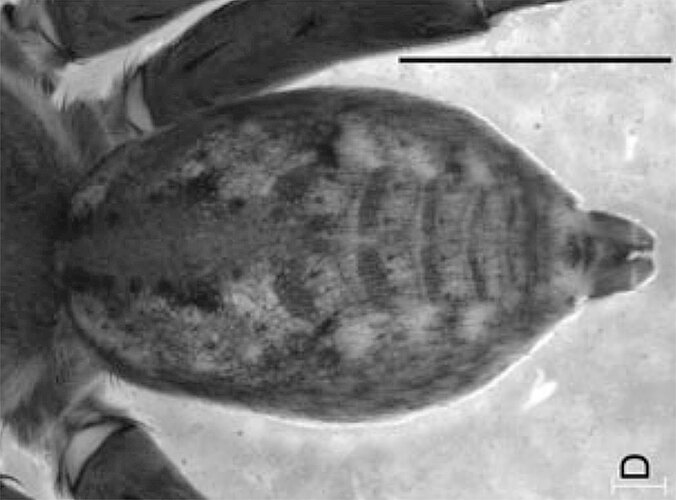Brennan's Hoggicosa Hoggicosa brennani Langlands& Framenau, 2010
Fauna Portal species: 6351Diagnosis
(after Langlands & Framenau 2010): The pedipalps of H. brennani most closely resemble those of H. castanea and H. forresti. The pars pendula, which is transparent in H. brennani and joins below the embolus tip, may be used to distinguish it from H. castanea, in which it is opaque and joins at the embolus tip. In addition the subterminal apophysis of H. brennani is much longer than that of H. castanea. The ventral process on the tegular apophysis of H. brennani has a flange on the prolateral side which is absent in H. forresti. Male and female H. brennani have a pale venter with dark patterning, whereas H. castanea and H. forresti have a black venter.
Status
- native
Linnean Holotype
Australia
- New South Wales
- Queensland
- South Australia
Fauna Portal Records
The map shows all records that have been verified as part of the Fauna Portal project and may not represent the true distribution of a species. Specifically, for described species, check the link to the Atlas of Living Australia on this page for potential wider distributions. Fauna Portal Reference specimens and Linnean types are shown in red. If you identified a specimen that exceeds the distribution of an undescribed species as illustrated here, please contact the Fauna Portal team who can assist with the lodgement of the specimen in a public institution and display on the map.
Similar Species
Publications
Langlands P.R. &. Framenau V.W. (2010): Systematic revision of Hoggicosa Roewer, 1960, the Australian 'bicolor' group of wolf spiders (Araneae: Lycosidae). Zoological Journal of the Linnean Society. 158: 83 - 123
Araneae (Spiders)
- Actinopodidae
- Anamidae
- Araneae fam. indet.
- Araneidae
- Archaeidae
- Argyronetidae
- Arkyidae
- Barychelidae
- Cheiracanthiidae
- Clubionidae
- Corinnidae
- Cycloctenidae
- Deinopidae
- Desidae
- Dictynidae
- Filistatidae
- Gnaphosidae
- Halonoproctidae
- Hersiliidae
- Idiopidae
- Lamponidae
- Linyphiidae
- Lycosidae
- Allotrochosina
- Anomalosa
- Artoria
- Artoriopsis
- Costacosa
- Diahogna
- Dingosa
- Genus 2556 (ariadnae grp)
- Genus 3448 (leonhardii gp)
- Genus 3491 (laeta grp)
- Genus 3643 (yalkara grp)
- Hoggicosa
- Hogna
- Kangarosa
- Knoelle
- Kochosa
- Lycosidae gen. indet.
- Mainosa
- Portacosa
- Tapetosa
- Tasmanicosa
- Tetralycosa
- Tuberculosa
- Venator
- Venatrix
- Venonia
- Zoica
- Allotrochosina
- Mimetidae
- Miturgidae
- Mysmenidae
- Nicodamidae
- Oecobiidae
- Oonopidae
- Oxyopidae
- Philodromidae
- Pholcidae
- Pisauridae
- Prodidomidae
- Salticidae
- Scytodidae
- Segestriidae
- Selenopidae
- Sparassidae
- Symphytognathidae
- Tetrablemmidae
- Tetragnathidae
- Theridiidae
- Thomisidae
- Trachelidae
- Trachycosmidae
- Trochanteriidae
- Uloboridae
- Zodariidae
- Zoropsidae
All classes
- Arachnida
- Crustacea
- Entognatha
- Gastropoda
- Insecta
- Blattodea s. str. (Cockroaches)
- Coleoptera (Beetles)
- Dermaptera (earwigs)
- Diptera (flies, mosquitos)
- Entomobryomorpha (slender springtails)
- Hemiptera - Auchenorrhyncha (cicadas, planthoppers)
- Hemiptera - Heteroptera (True Bugs)
- Hemiptera - Sternorrhyncha (aphids, scales etc.)
- Hymenoptera - Formicidae (Ants)
- Hymenoptera excl. Formicidae (bees and wasps)
- Orthoptera - Caelifera (Grasshoppers)
- Trichoptera (Caddisflies)
- Zygentoma (silverfish)
- Myriapoda

